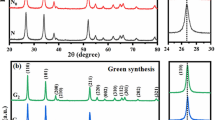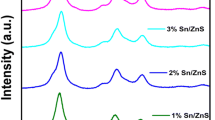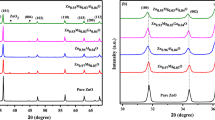Abstract
In this paper, we grab to utilize one of the trending techniques with efficient implications in wastewater treatment of organic pollutants, the photocatalytic degradation method shining out in the research field. Herein, tin (Sn)–doped zinc oxide (ZnO) nanoparticles (NPs) (Sn/ZnO) with different doping concentrations (1, 2, 3, 4, and 5 wt%) were synthesized via a simple co-precipitation assisted method and later subjected for their physico-chemical, morphological, and optical characterization. In addition, photocatalytic activity as the concerned study was investigated as to record the different doping levels of Sn/ZnO to examine the effect of doping concentration in relation with the degradation efficiency. We know that the optical bandgap of pure ZnO was 3.26 eV while it tends to increase slightly upon increasing the doping concentration. In the present investigation, methylene blue (MB) dye was used as a model pollutant to evaluate the photocatalytic activity of Sn/ZnO photocatalysts under natural sunlight. Varied doping concentrations of Sn/ZnO were compared with different characterization techniques while XRD analysis shows up 4-Sn/ZnO with sharp peak at (1 0 1) plane with smaller grain size in comparison to other Sn/ZnO samples. The morphological recognition depicts the hexagonal structure with smaller size for 4-Sn/ZnO which offers more active sites with improved photocatalytic activity, higher surface area for the transportation of pollutants. Fluorescence spectra results revealed that Sn dopant suppresses the charge carrier recombination. The lower intensity of PL indicated reduced recombination rate, which resulted in enhancing the photocatalytic activity. To investigate the possible mechanism, kinetics and reusability studies were performed. The 4% Sn-doped ZnO nanoparticle concentration showed highest photocatalytic activity when compared with other doping levels.









Similar content being viewed by others
Data availability
The data and materials are available.
References
Al-Gaashani R, Radiman S, Daud AR, Tabet N, Al-Douri Y (2013) XPS and optical studies of different morphologies of ZnO nanostructures prepared by microwave methods. Ceram Int 39:2283–2292. https://doi.org/10.1016/j.ceramint.2012.08.075
Ameen S, Akhtar MS, Seo H, Soon Y, Shik H (2012) Influence of Sn doping on ZnO nanostructures from nanoparticles to spindle shape and their photoelectrochemical properties for dye sensitized solar cells. Chem Eng J 187:351–356. https://doi.org/10.1016/j.cej.2012.01.097
Arshad M, Qayyum A, Abbas G, Haider R, Iqbal M, Nazir A (2018) Influence of different solvents on portrayal and photocatalytic activity of tin-doped zinc oxide nanoparticles. J Mol Liq 260:272–278. https://doi.org/10.1016/j.molliq.2018.03.074
Bae SY, Na CW, Kang JH, Park J (2005) Comparative structure and optical properties of Ga-, In-, and Sn-doped ZnO nanowires synthesized via thermal evaporation. J Phys Chem B 109:2526–2531. https://doi.org/10.1021/jp0458708
Barrientos L, Allende P, Laguna-Bercero MÁ, Pastrián J, Rodriguez-Becerra J, Cáceres-Jensen L (2018) Controlled Ag-TiO2 heterojunction obtained by combining physical vapor deposition and bifunctional surface modifiers. J Phys Chem Solids 119:147–156. https://doi.org/10.1016/j.jpcs.2018.03.046
Bedia FZ, Bedia A, Aillerie M, Maloufi N, Benyoucef B (2015) Structural, optical and electrical properties of Sn-doped zinc oxide transparent films interesting for organic solar cells (OSCs). Energy Procedia 74:539–546. https://doi.org/10.1016/j.egypro.2015.07.745
Beura R, Pachaiappan R, Thangandurai P (2018) A detailed study on Sn4+ doped ZnO for enhanced photocatalytic degradation. Appl Surf Sci 433:887–898. https://doi.org/10.1016/j.apsusc.2017.10.127
Bindhu MR, Ancy K, Umadevi M, Esmail GA, Al-Dhabi NA, Arasu MV (2020) Synthesis and characterization of zinc oxide nanostructures and its assessment on enhanced bacterial inhibition and photocatalytic degradation. J Photochem Photobiol B Biol 210:111965. https://doi.org/10.1016/j.jphotobiol.2020.111965
Chen X, Wu Z, Liu D, Gao Z (2017) Preparation of ZnO Photocatalyst for the efficient and rapid photocatalytic degradation of azo dyes. Nanoscale Res Lett 12:4–13. https://doi.org/10.1186/s11671-017-1904-4
Christie RM (2001) Colour chemistry, 2nd edn. The Royal Society of Chemistry, Cambridge, United Kingdom.
Devi RA, Latha M, Velumani S, Oza G, Reyes-Figueroa P, Rohini M, Becerril-Juarez IG, Lee J-H, Yi J (2015) Synthesis and characterization of cadmium sulfide nanoparticles by chemical precipitation method. J Nanosci Nanotechnol 15:8434–8439. https://doi.org/10.1166/jnn.2015.11472
Ertis IF, Boz I (2017) Synthesis and characterization of metal-doped (Ni, Co, Ce, Sb) CdS catalysts and their use in methylene blue degradation under visible light irradiation. Mod Res Catal 6:72672. https://doi.org/10.4236/mrc.2017.61001
Eskizeybek V, Sarı F, Gülce H, Gülce A, Avcı A (2012) Environmental preparation of the new polyaniline/ZnO nanocomposite and its photocatalytic activity for degradation of methylene blue and malachite green dyes under UV and natural sun lights irradiations. Appl Catal B Environ 119–120:197–206. https://doi.org/10.1016/j.apcatb.2012.02.034
Ganesh V, Yahia IS, AlFaify S, Shkir M (2017) Sn-doped ZnO nanocrystalline thin films with enhanced linear and nonlinear optical properties for optoelectronic applications. J Phys Chem Solids 100:115–125. https://doi.org/10.1016/j.jpcs.2016.09.022
Hong R, Pan T, Qian J, Li H (2006) Synthesis and surface modification of ZnO nanoparticles. Chem Eng J 119:71–81. https://doi.org/10.1016/j.cej.2006.03.003
Karthick K, Dinesh C, Namasivayam C (2014) Utilization of ZnCl2 activated Jatropha husk carbon for the removal of reactive and basic dyes: adsorption equilibrium and kinetic studies. Sustain Environ Res 24:139–148
Kumar DD, Nair PB, Justinvictor VB, Thomas PV (2016) Structural & optical properties of zinc oxide nanorods prepared by aqueous solution route. Chemist 89:1–5
Kumar DR, Ranjith KS, Nivedita LR, Asokan K, Rajendra Kumar RT (2019) Swift heavy ion induced effects on structural, optical and photo-catalytic properties of Ag irradiated vertically aligned ZnO nanorod arrays. Nucl Instruments Methods Phys Res Sect B Beam Interact with Mater Atoms 450:95–99. https://doi.org/10.1016/j.nimb.2018.03.015
Lam SM, Kee MW, Sin JC (2018) Influence of PVP surfactant on the morphology and properties of ZnO micro/nanoflowers for dye mixtures and textile wastewater degradation. Mater Chem Phys 212:35–43. https://doi.org/10.1016/j.matchemphys.2018.03.002
Liu X, Liu HL, Zhang WX, Li XM, Fang N, Wang XH, Wu JH (2015) Facile synthesis and photocatalytic activity of bi-phase dispersible Cu-ZnO hybrid nanoparticles. Nanoscale Res Lett 10:195–204. https://doi.org/10.1186/s11671-015-0895-2
Lv T, Pan L, Liu X, Lu T, Zhu G, Sun Z (2011) Enhanced photocatalytic degradation of methylene blue by ZnO-reduced graphene oxide composite synthesized via microwave-assisted reaction. J Alloys Compd 509:10086–10091. https://doi.org/10.1016/j.jallcom.2011.08.045
Lv T, Pan L, Liu X, Sun Z (2012) Enhanced photocatalytic degradation of methylene blue by ZnO–reduced graphene oxide–carbon nanotube composites synthesized via microwave-assisted reaction. Catal Sci Technol 2:2297–2301. https://doi.org/10.1039/C2CY20023F
Ma H, Williams PL, Diamond SA (2013) Ecotoxicity of manufactured ZnO nanoparticles - a review. Environ Pollut 172:76–85. https://doi.org/10.1016/j.envpol.2012.08.011
Mardani HR, Forouzani M, Ziari M, Biparva P (2015) Visible light photo-degradation of methylene blue over Fe or Cu promoted ZnO nanoparticles. Spectrochim Acta Part A Mol Biomol Spectrosc 141:27–33. https://doi.org/10.1016/j.saa.2015.01.034
Medhi R, Marquez MD, Lee TR (2020) Visible-light-active doped metal oxide nanoparticles: review of their synthesis, properties, and applications. ACS Appl Nano Mater 3:6156–6185. https://doi.org/10.1021/acsanm.0c01035
Murugadoss G (2012) Synthesis and characterization of transition metals doped ZnO nanorods. J Mater Sci Technol 28:587–593. https://doi.org/10.1016/S1005-0302(12)60102-9
Murugadoss G, Ramasamy V (2012) Structural and optical study of mixed structure of ZnO(hexagonal)/ZnS(cubic) nanocomposites. Spectrochim Acta - Part A Mol Biomol Spectrosc 93:290–294. https://doi.org/10.1016/j.saa.2012.03.010
Murugadoss G, Jayavel R, Rajesh Kumar M (2015) Structural and optical properties of highly crystalline Ce, Eu and co-doped ZnO nanorods. Superlattice Microst 82:538–550. https://doi.org/10.1016/j.spmi.2015.03.010
Murugadoss G, Jayavel R, Thangamuthu R, Rajesh Kumar M (2016) PbO/CdO/ZnO and PbS/CdS/ZnS nanocomposites: studies on optical, electrochemical and thermal properties. J Lumin 170:78–89. https://doi.org/10.1016/j.jlumin.2015.10.034
Pan K, Zhou W (2020) Surface oxygen vacancy defect-promoted electron-hole separation for porous defective ZnO hexagonal plates and enhanced solar-driven photocatalytic performance. Chem Eng J 379:122295–122305. https://doi.org/10.1016/j.cej.2019.122295
Rafatullah M, Sulaiman O, Hashim R, Ahmad A (2010) Adsorption of methylene blue on low-cost adsorbents: a review. J Hazard Mater 177:70–80. https://doi.org/10.1016/j.jhazmat.2009.12.047
Ramasamy V, Anandan C, Murugadoss G (2013) Structural, morphological and photoluminescence studies of multi shells coated ZnO nanocomposites. Superlattice Microst 61:106–114. https://doi.org/10.1016/j.spmi.2013.06.021
Rekha K, Nirmala M, Nair MG, Anukaliani A (2010) Structural, optical, photocatalytic and antibacterial activity of zinc oxide and manganese doped zinc oxide nanoparticles. Phys B Phys Condens Matter 405:3180–3185. https://doi.org/10.1016/j.physb.2010.04.042
Saleh R, Taufik A (2019) Degradation of methylene blue and congo-red dyes using Fenton, photo-Fenton, sono-Fenton, and sonophoto-Fenton methods in the presence of iron(II,III) oxide/zinc oxide/graphene (Fe3O4/ZnO/graphene) composites. Sep Purif Technol 210:563–573. https://doi.org/10.1016/j.seppur.2018.08.030
Sankar Ganesh R, Navaneethan M, Mani GK, Ponnusamy S, Tsuchiya K, Muthamizhchelvan C, Kawasaki S, Hayakawa Y (2017) Influence of Al doping on the structural, morphological, optical, and gas sensing properties of ZnO nanorods. J Alloys Compd 698:555–564. https://doi.org/10.1016/j.jallcom.2016.12.187
Saravanan R, Shankar H, Prakash T, Narayanan V, Stephen A (2011) ZnO/CdO composite nanorods for photocatalytic degradation of methylene blue under visible light. Mater Chem Phys 125:277–280. https://doi.org/10.1016/j.matchemphys.2010.09.030
Saravanan R, Karthikeyan S, Gupta VK, Sekaran G, Narayanan V, Stephen A (2013) Enhanced photocatalytic activity of ZnO/CuO nanocomposite for the degradation of textile dye on visible light illumination. Mater Sci Eng C 33:91–98. https://doi.org/10.1016/j.msec.2012.08.011
Shao R, Sun L, Tang L, Chen Z (2013) Preparation and characterization of magnetic core–shell ZnFe2O4@ZnO nanoparticles and their application for the photodegradation of methylene blue. Chem Eng J 217:185–191. https://doi.org/10.1016/j.cej.2012.11.109
Sirelkhatim A, Mahmud S, Seeni A (2015) Review on zinc oxide nanoparticles : antibacterial activity and toxicity mechanism. Nano-Micro Lett 7:219–242. https://doi.org/10.1007/s40820-015-0040-x
Siva N, Sakthi D, Ragupathy S, Arun V, Kannadasan N (2020) Synthesis, structural, optical and photocatalytic behavior of Sn doped ZnO nanoparticles. Mater Sci Eng B Solid-State Mater Adv Technol 253:114497. https://doi.org/10.1016/j.mseb.2020.114497
Song S, Wu K, Wu H, Guo J, Zhang L (2019) Effect of Fe/Sn doping on the photocatalytic performance of multi-shelled ZnO microspheres: experimental and theoretical investigations. Dalton Trans 48:13260–13272. https://doi.org/10.1039/C9DT02582K
Sun J-H, Dong S-Y, Feng J-L, Yin X-J, Zhao X-C (2011) Enhanced sunlight photocatalytic performance of Sn-doped ZnO for Methylene Blue degradation. J Mol Catal A Chem 335:145–150. https://doi.org/10.1016/j.molcata.2010.11.026
Sun H, Liu S, Liu S, Wang S (2014) A comparative study of reduced graphene oxide modified TiO2, ZnO and Ta2O5 in visible light photocatalytic/photochemical oxidation of methylene blue. Appl Catal B Environ 146:162–168. https://doi.org/10.1016/j.apcatb.2013.03.027
Surya S, Thangamuthu R, Senthil Kumar SM, Murugadoss G (2017) Synthesis and study of photovoltaic performance on various photoelectrode materials for DSSCs: optimization of compact layer on nanometer thickness. Superlattice Microst 102:424–441. https://doi.org/10.1016/j.spmi.2017.01.003
Verma M, Dwivedi PK, Das B (2015) Structure–property correlation of pure and Sn-doped ZnO nanocrystalline materials prepared by co-precipitation. J Exp Nanosci 10:438–448. https://doi.org/10.1080/17458080.2013.840936
Whang TJ, Hsieh MT, Chen HH (2012) Visible-light photocatalytic degradation of methylene blue with laser-induced Ag/ZnO nanoparticles. Appl Surf Sci 258:2796–2801. https://doi.org/10.1016/j.apsusc.2011.10.134
Yang Z, Lv L, Dai Y, Xv Z, Qian D (2010) Synthesis of ZnO–SnO2 composite oxides by CTAB-assisted co-precipitation and photocatalytic properties. Appl Surf Sci 256:2898–2902. https://doi.org/10.1016/j.apsusc.2009.11.047
Yurddaskal M, Yildirim S, Dikici T, Yurddaskal M, Erol M, Aritman I, Celik E (2018) Enhanced photocatalytic properties of Sn-doped ZnO nanoparticles by flame spray pyrolysis under UV light irradiation. J Turk Chem Soc Sect A Chem 5:15–22. https://doi.org/10.18596/jotcsa.370748
Zhang D, Zeng F (2012) Visible light-activated cadmium-doped ZnO nanostructured photocatalyst for the treatment of methylene blue dye. J Mater Sci 47:2155–2161. https://doi.org/10.1007/s10853-011-6016-4
Acknowledgments
We thank the CSIR-CECRI, DST-SERI (DST/TM/SERI/FR/172(G)), UGC-SAP, New Delhi for the instrumentation facilities and financial supports; the RUSA 2.0-BEIC for providing research grant; and the Department of Nanoscience and Technology, Bharathiar University for providing instrumentation facilities. The author Dr. G. Murugadoss thanks the Chancellor, President, and Vice Chancellor, Sathyabama Institute of Science and Technology, Chennai for the support and encouragement.
Funding
Research grants from funding agencies of CSIR-CECRI, DST-SERI (DST/TM/SERI/FR/172(G)), UGC-SAP, New Delhi, India, and research supported from the Department of Nanoscience and Technology, Bharathiar University for provide funding (RUSA 2.0-BEIC) and instrumentation facilities and Sathyabama Institute of Science and Technology, Chennai for providing facilities where part of characterization studies were carried out.
Author information
Authors and Affiliations
Contributions
Nachimuthu Venkatesh,
Development or design of methodology; creation of models.
Conducting a research and investigation process, specifically performing the experiments, or data/evidence collection.
Preparation, creation, and/or presentation of the published work, specifically writing the initial draft (including substantive translation).
Santhan Aravindan,
Application of statistical, mathematical, computational, or other formal techniques to analyze or synthesize study data.
Karuppathevan Ramki,
Application of statistical, mathematical, computational, or other formal techniques to analyze or synthesize study data.
Conducting a research and investigation process, specifically performing the experiments, or data/evidence collection.
Govindhasamy Murugadoss*,
Ideas; formulation or evolution of overarching research goals and aims.
Application of statistical, mathematical, and other formal techniques to analyze or synthesize study data.
Preparation, creation, and/or presentation of the published work by those from the original research group, specifically critical review, commentary, or revision—including pre- or post-publication stages.
In addition, ensured that all listed authors have approved the manuscript before submission, including the names and order of authors and managing all communication between the Journal and all co-authors, before and after publication
Rangasamy Thangamuthu,
Application of statistical, mathematical, computational, or other formal techniques to analyze or synthesize study data.
Pachagounder Sakthivel*
Application of statistical, mathematical, computational, or other formal techniques to analyze or synthesize study data.
Acquisition of the financial support for the project leading to this publication.
Preparation, creation, and/or presentation of the published work by those from the original research group, specifically critical review, commentary, or revision—including pre- or post-publication stages.
Corresponding authors
Ethics declarations
Ethical approval
Not applicable.
Consent to participate
The authors agreed that they participating in the research work.
Consent to publish
The authors agreed to publish this research paper.
Competing interests
The authors declare that they have no competing interests.
Additional information
Responsible Editor: Sami Rtimi
Publisher’s note
Springer Nature remains neutral with regard to jurisdictional claims in published maps and institutional affiliations.
Supplementary Information
ESM 1
(DOCX 685 kb)
Rights and permissions
About this article
Cite this article
Venkatesh, N., Aravindan, S., Ramki, K. et al. Sunlight-driven enhanced photocatalytic activity of bandgap narrowing Sn-doped ZnO nanoparticles. Environ Sci Pollut Res 28, 16792–16803 (2021). https://doi.org/10.1007/s11356-020-11763-3
Received:
Accepted:
Published:
Issue Date:
DOI: https://doi.org/10.1007/s11356-020-11763-3




